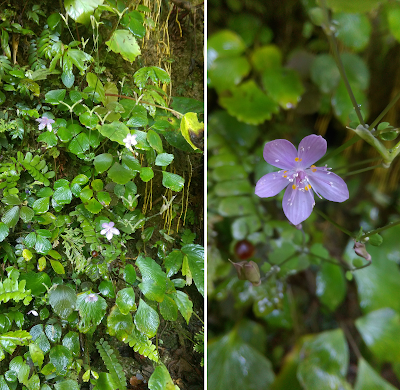 |
| Dichocarpum hagiangense L.K Phan & V.T. Pham in Nguyen, Trinh, ... et Pham, 2020. DOI: 10.7717/peerj.9874 |
Abstract
Dichocarpum hagiangense from Ha Giang province, northern Vietnam is described and illustrated. Diagnostic features of the new species are a short rhizomatous stem, (2–)3-foliolate or simple leaves, and pink-purple flowers. The described species is distinct from closely allied D. trifoliolatum in having longer sepals, shape and obcordate apex of petal limbs, shorter flower stem, number and tooth shape of basal leaves; it differs from D. basilare and D. carinatum in having stem leaf, retuse apex and longer of central leaflet, number and (2–)3-foliated (or simple) of leaf. With the support of molecular data, the new species was clearly distinguished from other species in the Dichocarpum group by eight autapomorphic characters in nrITS sequence. A key to all species of Dichocarpum is provided. We suggest the IUCN conservation status of D. hagiangense to be “Critically Endangered”. A newest checklist of the family Ranunculaceae in Vietnam is updated.
 |
| Figure 4: Dichocarpum hagiangense L.K. Phan & V.T. Pham in its natural habitat. (A) Rocky cliff at the limestone forest. (B) Plant with inflorescence. (C) Flower. |
Dichocarpum hagiangense L.K Phan & V.T. Pham, sp. nov.
Diagnosis. According molecular characters new species belong to sect. Dichocarpum, subsect. Dichocarpum. Dichocarpum hagiangense is morphologically most similar to D. trifoliolatum, but differs in having longer sepals, shape and obcordate apex of petal limbs, shorter flower stem, number and tooth shape of basal leaves. However, D. hagiangense differs from D. basilare and D. carinatum in having stem leaf, retuse apex and longer of central leaflet, number and (2–)3-foliated (or simple) of leaf.
Habitat and ecology. The new species grows in disturbed primary evergreen forest on a limestone mountain at elevations of 1297 m, as a lithophytic herb on large wet mossy boulders and cliffs on steep slopes (Fig. 4).
Distribution and Conservation status. Dichocarpum hagiangense was only recorded from one small population in Ha Giang province of Vietnam (Fig. 1). The existing population is facing the risk of extinction in the wild, since the area where this species is found does not belong to any protected forest. The habitat is highly disturbed by the local people for cardamom and Lysimachia foenum-graecum cultivations, collecting timber, firewood and non-timber forest products. The species is very rare and only known from one population of less than 50 mature individuals, in a habitat that is seriously threatened. According to IUCN Standards and Petitions Subcommittee (2019) criteria B1ab(ii) + B2ab(ii), with EOO (Extent of Occurrence) = 0 km2 and AOO (Area of Occupancy) = 4.000 km2, this species should be classified as “critically endangered” (CR).
Etymology. The species epithet ‘hagiangense’ refers to Ha Giang province, the only site where the species is currently known.
Minh Ty Nguyen, Ngoc Bon Trinh, Thanh Thi Viet Tran, Tran Duc Thanh, Long Ke Phan and Van The Pham. 2020. Dichocarpum hagiangense—A New Species and An updated Checklist of Ranunculaceae in Vietnam. PeerJ. 8:e9874. DOI: 10.7717/peerj.9874

